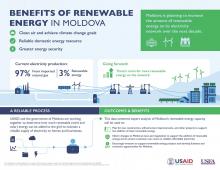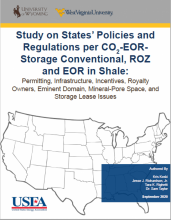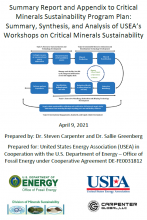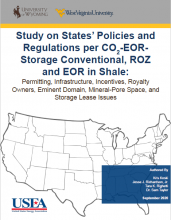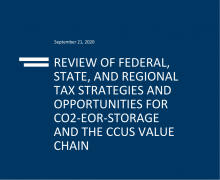November 16th, 2022
This report describes the status of carbon dioxide (CO2) removal (CDR) technologies, life cycle greenhouse gas emissions for real-world CDR applications, and recommendations for CDR development in the US.
September 30th, 2020
With the help of the University of Wyoming and West Virginia University, USEA released a "Study on State's Policies & Regulations per CO2-EOR Storage Conventional, ROZ and EOR in Shale: Permitting, Infrastructure, Incentives, Royalty Owners, Eminent Domain, Mineral-Pore Space, and Storage." This study evaluates laws, policies, and regulations governing CO2-EOR, associated CO2 storage operations, and geologic storage across twelve states and onshore federal lands.
April 9th, 2021
Beginning in November 2020, USEA, in cooperation with the U.S. Department of Energy's Office of Fossil Energy (DOE-FE), and Carpenter Global organized a series of monthly Regional Workshops on Critical Minerals Sustainability. The objective of the workshops was to assist DOE-FE in its stakeholder information gathering efforts regarding the building out of a Domestic and Sustainable Critical Minerals Supply Chain. Held virtually, the workshops focused on the following regions: Western U.S. (November), Appalachia and Eastern U.S.
December 2nd, 2020
With the help of the University of Wyoming and West Virginia University, USEA is releasing a "Study on State's Policies & Regulations per CO2-EOR Storage Conventional, ROZ and EOR in Shale: Permitting, Infrastructure, Incentives, Royalty Owners, Eminent Domain, Mineral-Pore Space, and Storage." This study evaluates laws, policies, and regulations governing CO2-EOR, associated CO2 storage operations, and geologic storage across twelve states and onshore federal lands.
November 9th, 2020
The November 2020 issue of Public Utilities Fortnightly.
September 21st, 2020
Carbon capture and storage projects are rapidly emerging as lucrative investment opportunities, due to a combination of federal and state tax credits and other incentives. But for states, counties, utilities, and corporations seeking to meet carbon emission reduction goals—and for the investment community seeking to fund these projects—it can be difficult to understand and apply the various incentives that exist. This report from the United States Energy Association (USEA) and the US Department of Energy (DOE), prepared by Orrick and FTI Consulting, offers insights into these complexities.
Pages

